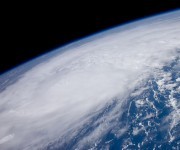Hurricane Irene.Photo: NASA’s Marshall Space Flight CenterCross-posted from Natural Resources Defense Council.
Like most people on the East Coast, I’m anxiously watching the approach of Hurricane Irene, a swirling knot of wind and rain taking dead aim at New York City, where I’m currently visiting my family. I had been hoping to fly home to California on Monday morning, but now I’m wondering if that will happen. I’m also wondering about what kind of damage and health threats this hurricane will bring.
Almost precisely six years ago today, I watched anxiously as Hurricane Katrina bore down on the Gulf Coast. After that disaster, I was part of a health response team mobilized to evaluate the environmental damage in New Orleans. I remember entering the flooded city horrified and awed at the destruction that happened there — cars flipped on their roofs and piled on top of each other, houses obliterated or moved from their foundations, and the chalk marks on homes showing the death toll inside. We created a photo journal and investigated the serious health threats from rampant mold, arsenic-laced sediment and soil, and contaminated drinking water.
One of the shocking things about the flooding of New Orleans was how predictable it was. The city was well-known to be vulnerable to hurricanes, and the levees were documented to be insufficient to withstand a powerful storm. Yet the failure to adequately prepare — both in the long term by building stronger levees, and in the short term by evacuating people from vulnerable areas — lead to nearly 2,000 deaths, the displacement of about 800,000 people, and an estimated cost of well over $120 billion dollars.
Today, New York City is staring down the barrel of a loaded gun named Irene.
Like New Orleans, New York and nearby areas are also known to be vulnerable to hurricanes, although the region has been lucky and hasn’t been hit with a major hurricane since 1821. Our luck may have just run out. High tide and storm surge could flood the New York subway system and roadways, large parts of lower Manhattan, and other coastal areas such as Long Island. High winds roaring through the urban canyons of New York propelling flying debris through windows is a really scary thought.
It’s hard to say what will happen when Hurricane Irene hits, and it will certainly look different from the Katrina disaster, but there’s a really high likelihood of over a billion dollars of damage to property, and — unfortunately — many lost lives. But it’s not only New York that’s at risk. A major portion of the Eastern seaboard is in the storm track. To find out if you live in an area vulnerable to flooding along the East Coast, check out these flood vulnerability maps that allow you to search for your local area. Or if you live in New York City, you can check this site to determine your risk. If you live in a flood zone, be prepared to evacuate if you need to. See my colleague Kim Knowlton’s blog for information about how to prepare for the storm.
Climate change is projected to significantly increase the intensity of hurricanes and other storms. We have already seen a record-breaking year in 2011, with major winter storms, tornadoes in the spring, record-breaking heatwaves this summer, and now, a potentially devastating hurricane. Things are so bad that the new “normal” weather is swinging into a pattern of extremes. The climate-related events of 2011 so far bear an estimated price tag of $265 billion, at a time when our nation can ill afford it.
Our climate is already changing right before our eyes, and it’s not a pretty sight. As a health professional, I am pleading with politicians in Washington, D.C. to take practical steps to deal with climate change … Before it deals with us.



